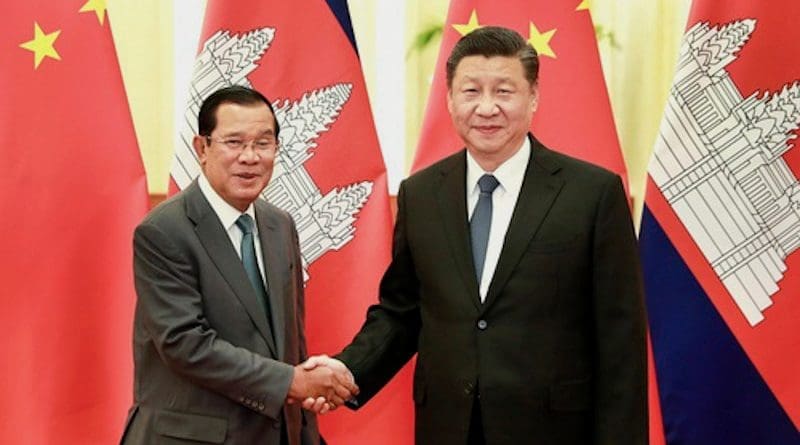Cambodia’s Opportunities From Chinese Trade Platforms – OpEd
Cambodia, one of the trusted allies of China, is confronting challenges of economic vulnerability as a result of the Covid-19 pandemic, climate change and limited export destinations. Simultaneously, a rising trend of trade protectionism with new hidden barriers and de-globalization in the global market are impeding the economic and investment sectors of Cambodia. In this context, China’s open door and cooperation policy offers a glimmer of hope for the neighboring countries’ prosperity and development, resuming economic growth at a faster rate. In order to fulfill President Xi Jinping’s pledge, China has taken a number of concrete steps in recent years, including one that lets foreign enterprises greater access to the domestic market and a foreign investment law that ensures a business-friendly environment. At the same time, China has taken new steps to strengthen bilateral and regional cooperation by joining trade blocs such as the RCEP, and the CPTPP, hosting a series of mega trade exhibitions and improving connectivity through the Belt and Road Initiative (BRI).
Of them, China Import and Export Exhibition (Canton Fair), China International Import Expo (CIIE), China International Fair for Trade in Services (CIFTIS), China-ASEAN expo, China-South Asia expo, Euro-Asia Economic Forum and Trade Cooperation Expo, Inter-textile Shanghai Apparel Fabrics, and China Yangling Agricultural High-tech Fair are all key exhibitions that will undoubtedly be of great significance to developing economies like Cambodia, Bangladesh, Nepal, Bhutan and Pakistan. It is expected that participation in these forums would open vistas of business opportunities and further enhance bilateral relations and co-operation.
Beijing has been Cambodia’s one of the major trade partner. According to data, Between January to May 2021, Cambodian exports to China were valued at US$558 million, an increase of 56 percent from the same period in 2020. Despite the fact that of the US$8 billion in bilateral trade in 2020, only US$1 billion was sent from Cambodia. On the other hand, from January to July 2021, the overall import and export volume of China and Bangladesh was US$13 billion, a rise of 58.9% year on year. However, despite the fact that bilateral trade favors China heavily, Cambodia and Bangladesh, Pakistan, Nepal and other South and East Asian countries have enormous potential that has yet to be realized. In the next ten years, China is expected to import a total of $22 trillion worth of goods. Hence, China’s Expo platform will provide a great opportunity for Cambodia and Bangladesh to explore the vast Chinese market and expand exports to bridge the bilateral trade gap and increase revenue.
Bangladesh’s major export items, readymade-garments and others including leather goods, jute and jute goods, agricultural products, frozen and live fish, pharmaceutical products, plastic, sports goods, handicrafts, and tea have strong competitive edge in the international market. But its limited exports destination (Mainly USA and EU) might put Bangladesh in a more challenging position due to US’s suspension of GSP and India’s imposition of anti-dumping duty Also to note, there is no guarantee to get into the EU’s GSP+ scheme on expiry of the “Everything but Arms (EBA)” initiative after graduation from the LDC group in 2026.
Similarly, Cambodia’s exports are dominated by textile goods, which account for around 70 percent of total exports. Other export products include vehicles, footwear, natural rubber and fish. Cambodia’s main export partners are the United States, Hong Kong, Singapore, Canada, Germany and the UK. The European Union’s (EU) withdrawn the EBA status in 2020 which provided duty-free access to EU markets. Amid such looming economic uncertainty, the good news is that China has provided duty-free access to 97% and 98% of Bangladeshi and Cambodian products respectively. That’s why, the expos are important ways to learn about Chinese consumer preferences and to tap into vast China market. Participating these expos both nations can display and popularize its flagship products and diversify its export destination globally as a large number of buyers, entrepreneurs and companies from Europe, America, Australia, Southeast Asia, Middle East, and Africa attend there.
According to officials at the Cambodian Ministry of Commerce, Cambodia and China are committed to increase bilateral commerce to $10 billion by 2023, up from $8 billion last year. To achieve this goal, The National Assembly of Cambodia ratified the bilateral free trade agreement (FTA) with China on September 9, 2021, with the goal of increasing goods trade by lowering and eliminating tariffs and non-tariff obstacles. Trade, tourism, investment, transportation, and agriculture are all included by the Cambodia-China Free Trade Agreement. China will grant duty-free status to 98 percent of Cambodian imports, while Cambodia has agreed to exemptions for up to 90 percent of its Chinese imports.
It is noteworthy, Bangladesh and Cambodia are constructing high-quality infrastructure, such as power plants, bridges, highways, railways, and ports, in collaboration with China. Now, both countries need to highlight the vast investment potential and create confidence in a large number of foreign investors through different international platforms organized by China.
In short, the expos offer a platform to understand Chinese market and China’s development as well as to make new linkage with consumers, companies, experts and different technologies which could lead product specialization and value addition in order to adapt to the conditions of China, a market with 1.4 billion people and over 400 million middle-income people. In this regard, China can provide technical assistance in framing policy positions and export-development strategy to help Bangladeshi and Cambodian products reach the Chinese market.
Like Cambodia and Bangladesh other South and East Asian countries, can also use the expos to promote their brands, build new trade image and expand their business opportunities in China and the worldwide market. Along with economic and commercial gains, such platforms would forge stronger cultural cooperation which will with further enhance the bilateral relations and promote partnership for win-win development.
*Parvej Siddique Bhuiyan, Masters in International Relations from Jahangirnagar University, Dhaka. Development Worker, Dhaka, Bangladesh.

